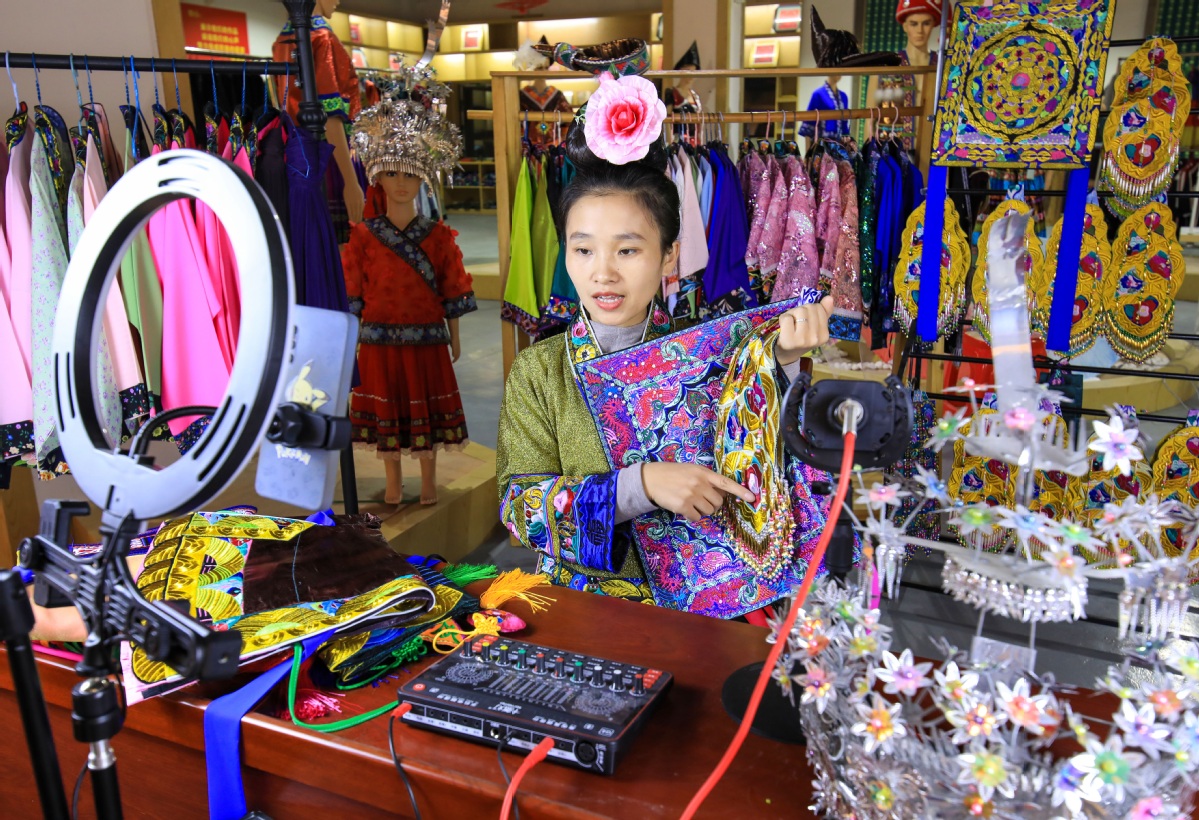Livestreaming critical for many, but unsustainable long-term
By Wang Gao | China Daily | Updated: 2022-01-17 11:13

Whether utilizing short-video apps or traditional e-commerce platforms, livestreaming is becoming an increasingly important strategy in marketing plans, with more livestreamers and brands flocking to livestreaming rooms.
What really matters in livestreaming shopping is viewership, where the size of the audience indicates the size of potential customers, and also determines how many sales a seller can close. This differentiates livestreaming shopping from street vending, where sales volumes are smaller due to limited pedestrian traffic. The advantage of online livestreaming shopping, on the contrary, is typified by its vast number of viewers-that is, customers are virtually unlimited thanks to the mobile internet.
In the long run, especially with the advent of 5G, livestreaming is an irreversible trend. So, will the development of livestreaming e-commerce also be irreversible?
Attracted en masse by sellers' marketing strategies and extremely tempting prices, Chinese consumers have long viewed Double 11 as a shopping carnival. They have developed a "splurging after refraining "mentality, piling items into virtual shopping carts but only placing orders when the big day arrives.
Key opinion leaders like Li Jiaqi, without a doubt, are top livestreaming celebrities and enjoy huge influence. However, they are also somehow outliers in the industry. Huge sales brought by these livestreaming superstars don't necessarily mean livestreaming is the best platform for attracting consumers.
First, livestreaming shopping only enjoys truly explosive growth during the annual Double 11 period. Second, if high sales revenue is achieved only using low prices, this approach is by no means sustainable. Instead, livestreaming shopping today resembles Taobao during its early years, with cutthroat price competition and brands and retailers significantly reducing costs to squeeze out profits while boosting market share and brand recognition. This approach leads to sacrificing the quality of manufacturing and raw materials, resulting in industrial regression.
Moreover, if online shops choose not to use livestreaming yet to offer the best deals, consumers will still go for them. Hence, we can see that livestreaming shopping does not necessarily go hand-in-hand with a robust bottom line.
Yes, it is true that the internet continues to evolve. It is also true that livestreaming e-commerce is a new form of selling that platforms and retailers should embrace. However, if they unrealistically rely on this new approach to push sales through the roof, disappointment will be a strong possibility.
Let's do the math: During the Double 11 period, brands often slash prices by 50 percent, pay upward of 20 percent commissions to high-profile livestreamers like Li Jiaqi, and give another 5 percent to e-commerce platforms. If a brand expects to make a profit, it should have a gross margin of at least 60 percent. And here comes the key question: How many players in the market can secure a 60 percent gross margin?
Panacea or poison?
Ironically, some brands say: "During Double 11, the more you sell, the more you lose. In the end, you sit there alone, shedding tears."
How can companies, especially startups, develop a healthy model for marketing and sales to boost future growth?
In general, startups record lower sales volumes than more established brands. They need time to develop and attract followers, and significant sales growth cannot be achieved in one fell swoop.
Perfect Diary, a well-known Chinese beauty brand, once launched extensive digital marketing campaigns on its social media platforms, endorsed by top KOLs and other celebrities. As a result, the brand conquered platforms like WeChat and Weibo. In June 2019, Perfect Diary ranked second among "Gen-Z's Most Loved Brands" on T-Mall. During Double-11 that year, it became the first domestic brand ever to top T-Mall's beauty category.
In March 2021, three months after listing in New York, Perfect Diary's parent company Yatsen E-commerce released its unaudited financial results from 2020. The report showed that the company's net revenue stood at 5.2 billion yuan in 2020, up 72.7 percent year-on-year. However, intensive investment in branding, marketing, research and development, and physical store expansion led to escalating costs in operations and administration, resulting in a full-year net loss of nearly 2.7 billion yuan.
Working with top livestreamers is like a double-edged sword for brands. While it is not rare for new brands to achieve overnight fame via livestreaming, adopting this approach as a panacea is dangerous. In the livestreaming rooms of Li Jiaqi, consumers are most often loyal to the livestreamers, not the brands. Thus, following the crowd and jumping into livestreaming may not lead to success. After all, what matters ultimately is how much money you make, not how many pieces of products you sell.
Livestreaming shopping, while effective in boosting sales, is no panacea. Brands have to return to rationality and think about whether they have won profits after selling their goods.
Someday down the road, if livestreamers are able to sell more products than the brands themselves do at the same price, they can determine their true value.
The future of retail will integrate e-commerce and bricks-and-mortar shops; retailers will combine traditional marketing processes and digital adaptations; products will be sold both online and at physical stores; and customers will come from private as well as public traffic pools. Therefore, when similar products are sold at fairly consistent prices across different platforms or distribution channels, livestreaming will no longer be a paradise that consumers flock to. And in the future, the operation of physical stores will be experience-oriented.
Today, e-commerce has achieved market saturation in China, and consumer demand does not have much room to grow. This indicates a slow growth for e-commerce in the future, whether it is traditional e-commerce, social e-commerce or overall interest e-commerce.
On traditional e-commerce platforms such as Taobao and JD, most consumers make planned purchases and search for specific shops or livestreaming rooms. However, it is a different story on short-video apps like Kuaishou and Douyin.
As of August 2020, Douyin had more than 600 million daily active users, with an average of 33 hours per capita a month. The market size is thus not hard to imagine. This sets off an alarm for traditional and social e-commerce platforms, which will need to put more effort into exploring the livestreaming world, encouraging brands to start their own livestreaming rooms and motivating KOLs to attract more consumers.
However, platforms also need to stay awake and keep a keen eye on the market. On the demand side, consumers have limited demand for products of the same kind, and the money they spend is also capped by their disposable income.
Brands have to know what they are looking for in developing livestreaming shopping.
Although livestreaming is not a sustainable sales and marketing method over the long term, it effectively boosts brand exposure, promotes new products, reduces inventory and competes with rivals.
In the past, advertising and distribution channels were disconnected. But today, the internet has brought them together. A banner or a short video popping up on a website can take consumers directly to the intended page of the product and close the deal.
At a time of profound changes, large and mature brands can make major forays into all these big platforms and invest resources into each of them. However, for small companies with limited resources, this approach may be unworkable.
Instead, they can adopt livestreaming shopping, but stop competing on price. Taking this approach, brands may not see skyrocketing sales in the short term, but will still find sustainability. Some players in the market have, in fact, already started to do this. An increasing number of brands have embarked on their own livestreaming journey. They have built livestreaming rooms at physical stores, creating a virtual shopping experience for online consumers. Thus, when launching a new product, they achieve commendable sales volume even without discounts.
However, only when brands make quality products can the channels used to sell them be determined by consumers. And this is where the future lies for livestreaming shopping.
The writer is a professor of marketing at China Europe International Business School in Shanghai.
The views don't necessarily reflect those of China Daily.























